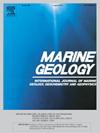Controls of paleosedimentary environments and anthropogenic activities on coastal groundwater salinization: A case study of Laizhou Bay, China
IF 2.2
3区 地球科学
Q2 GEOSCIENCES, MULTIDISCIPLINARY
引用次数: 0
Abstract
Groundwater salinization presents a substantial environmental challenge for coastal regions globally, particularly along the southern shore of Laizhou Bay. The processes contributing to groundwater salinization are intricate and involve interactions between natural factors and human activities. This study examines the mechanisms underlying groundwater salinization at varying depths in the southern Laizhou Bay area, with a particular emphasis on the effects of extensive groundwater extraction. Excessive groundwater extraction has intensified salinization by altering hydraulic gradients and promoting seawater intrusion. Utilizing sediment and pore water samples from two boreholes (SG100 and WF80) alongside shallow seismic data, we identified that sedimentary strata consisting of alternating marine and terrestrial deposits, formed during multiple transgressive events since the Late Pleistocene, are a significant source of salinity. Paleoenvironmental reconstructions based on grain size analysis, combined with Cl/Br ratios and stable isotope analysis, indicated that modern seawater intrusion is a primary driver of shallow groundwater salinization. In contrast, variations in deep groundwater salinity reflect differing paleoenvironmental recharge conditions. Ancient riverbed sediments exhibit high permeability, providing an efficient pathway for the transport of water and salts from upstream freshwater bodies. This process facilitates the dilution within the aquifer, leading to the formation of low-salinity groundwater. In contrast, the low permeability of floodplain sediments significantly restricts the renewal capacity of water bodies. As a result, the saline water layer maintains a high salinity state over extended periods due to the combined effects of evaporation and limited recharge. Notably, offshore freshwater was detected within ancient river channel deposits. These findings underscore the intricate interplay between sedimentary evolution and anthropogenic activities in influencing groundwater salinization, highlighting the necessity for scientifically informed, water-type-specific management strategies.

古沉积环境和人类活动对沿海地下水盐渍化的控制作用——以莱州湾为例
地下水盐渍化对全球沿海地区,特别是莱州湾南岸地区构成了严峻的环境挑战。导致地下水盐碱化的过程是复杂的,涉及自然因素和人类活动之间的相互作用。本研究探讨了莱州湾南部地区不同深度地下水盐渍化的机制,特别强调了地下水大量开采的影响。地下水的过度开采通过改变水力梯度和促进海水入侵而加剧了盐碱化。利用两个钻孔(SG100和WF80)的沉积物和孔隙水样本以及浅层地震数据,我们发现沉积地层由海相和陆相交替沉积组成,形成于晚更新世以来的多次海侵事件中,是盐度的重要来源。基于粒度分析的古环境重建,结合Cl/Br比值和稳定同位素分析,表明现代海水入侵是浅层地下水盐渍化的主要驱动因素。深层地下水盐度的变化反映了不同的古环境补给条件。古河床沉积物具有高渗透性,为上游淡水水体的水盐输送提供了有效途径。这一过程促进了含水层内部的稀释,从而形成低盐度地下水。而泛滥平原沉积物的低渗透性则严重限制了水体的更新能力。结果,由于蒸发和有限补给的综合作用,咸水层在较长时间内保持高盐度状态。值得注意的是,在古河道沉积物中发现了近海淡水。这些发现强调了影响地下水盐碱化的沉积演化和人为活动之间错综复杂的相互作用,强调了有必要制定有科学依据的、针对具体水类型的管理战略。
本文章由计算机程序翻译,如有差异,请以英文原文为准。
求助全文
约1分钟内获得全文
求助全文
来源期刊

Marine Geology
地学-地球科学综合
CiteScore
6.10
自引率
6.90%
发文量
175
审稿时长
21.9 weeks
期刊介绍:
Marine Geology is the premier international journal on marine geological processes in the broadest sense. We seek papers that are comprehensive, interdisciplinary and synthetic that will be lasting contributions to the field. Although most papers are based on regional studies, they must demonstrate new findings of international significance. We accept papers on subjects as diverse as seafloor hydrothermal systems, beach dynamics, early diagenesis, microbiological studies in sediments, palaeoclimate studies and geophysical studies of the seabed. We encourage papers that address emerging new fields, for example the influence of anthropogenic processes on coastal/marine geology and coastal/marine geoarchaeology. We insist that the papers are concerned with the marine realm and that they deal with geology: with rocks, sediments, and physical and chemical processes affecting them. Papers should address scientific hypotheses: highly descriptive data compilations or papers that deal only with marine management and risk assessment should be submitted to other journals. Papers on laboratory or modelling studies must demonstrate direct relevance to marine processes or deposits. The primary criteria for acceptance of papers is that the science is of high quality, novel, significant, and of broad international interest.
 求助内容:
求助内容: 应助结果提醒方式:
应助结果提醒方式:


